ADSactly Health - Sun Exposure, UV Rays and the Perfect Sunscreen
In (almost) every country, talking about summer makes us dream about getting a suntan on a far off sunny white beach while drinking a sweet cocktail. Smartphones switched off, some nice music playing, our partner quietly rubbing some lotion on our body...
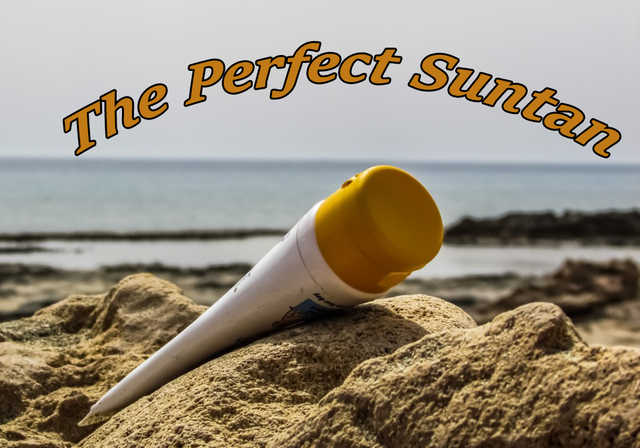
However, even if we are not lucky enough to live this kind of dream, we will surely be exposed to the sun a lot during summer. While a suntan can make us look cooler, chronic exposure to sun rays can induce several consequences for our health, ranging from sunburn to skin cancer. The lack of adequate information about sun exposure, UV rays and protective factor of sunscreen is the main reason of skin pathology during the hot season. This time I will try to make things a bit clearer on these topics so you can protect your skin properly and get the perfect, (safest) suntan, even if you will not get it while relaxing on a tropical shore.
Before I start talking about protection factors and tips to protect our skin, we need to understand how our skin is made and what UV rays are.
The skin, The layers, The cells
“Skin” may seem to non-expert people a simple word, which refers to our whole body “cover” (also available in different colours!). Actually, the skin is an organ (like the heart, the brain, etc.) made up of multiple layers of ectodermal tissue which protect our internal parts like muscles, bones, ligaments, internal organs. It consists in different layers of cells, but for the sake of simplicity, we will consider the three main layers: epidermis, dermis and hypodermis.
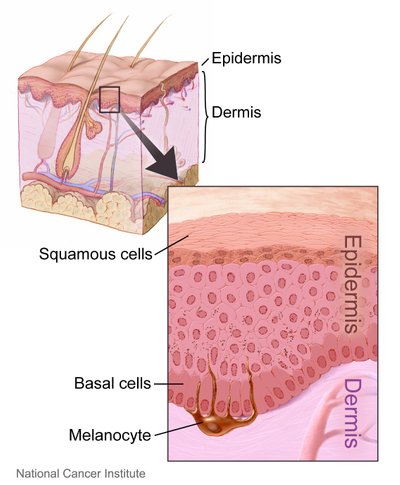 "
"
The Epidermis is the outer layer of our skin. It consists of different kind of cells: keratinocytes, melanocytes, Langerhans cells and Merkel cells. Keratinocytes are arranged in different layers: the deeper one consists of active cells, which replicate themselves while the outer ones are mainly dead cells that serve as physical barrier to external agents.
The Dermis is the layer between epidermis and subcutaneous tissue (hypodermis). It consists of dense connective tissue, proved strength and elasticity to skin thanks to the presence of elastic fibers, collagen fibrils and proteoglycans. The main cells found in the dermis are fibroblasts, macrophages and adipocytes. The epidermis and the dermis together are called “cutis”.
The Hypodermis consists mainly of fat and blood vessels, it serves as support tissue for outer layers of skin. We find here the same cells of dermis but most of them are adipocytes. Let’s learn a bit more about three of these cells:
Keratinocytes grow from a deep layer of active cells of epidermis, called “germinal layer”. The more the keratinocyte reach the outer skin, the more it becomes lifeless, decreasing its replication capability while increasing the quantity of keratin, a fibrous structural protein. In the most outer layer of epidermis, the “cornified layer”, the keratinocyte lose it’s nucleus and it is called corneocytes: the high quantity of keratin in these cells make our skin very resistant to chemical agents, oxidant stress, microbial agents and to mechanical hazards.
Melanocytes are found in the germinal layer of epidermis where they represent 5% to 10% of all cells. One of their roles is to produce melanine, a dark pigment that can be absorbed by outer keratinocytes making our skin look darker.
Fibroblasts are found in deeper layers of the skin, in the dermis and hypodermis. Their main role is to produce collagen fibers fibrils and other components of extracellular matrix.
The sun, The sky, The rays
Everyone knows what is the sun but maybe, only a few know that sunlight consists in different electromagnetic radiation (EMR), in particular infrared, ultraviolet and visible light. Visible light consists in EMR having wavelengths of 400-700 nanometres (nm) while in the non-visible electromagnetic spectrum, infrared and ultraviolet light, have respectively longer and shorter wavelengths ( 700 nm - 1 mm and 10-400 nm). So every sunray brings with it all these kind of radiations: for the purpose of this post we will focus on Ultraviolet radiation (UVR) which represent 10% of all radiation we get from the sun.
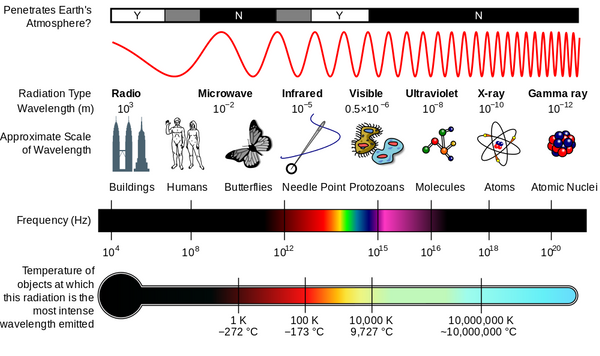
UVR can be differentiated by wavelength in:
- UVC (100-290 nm): they are totally absorbed by the ozone layer in the Earth atmosphere.
- UVB (290-320 nm): they are partially absorbed by the ozone layer and represent the 3,5% of the UVR that hits our skin.
- UVA (320-400 nm): they are not absorbed by the ozone layer and represent the 96,5% of the UVR that hits our skin. UVA are also divided in UVA1 and UVA2 depending on their wavelength but this is less important for our discussion.
When talking about sun exposure we will face the consequences mainly of UVB/UVA exposure. The amount of radiation absorbed by our skin depends on different factors:
- The current season (summer has more sunny days and less clouds)
- The latitude (lower latitude is reached by strongest sun rays)
- The hour of the day (influences solar elevation angle)
- Solar elevation angle (when the sun is high the exposure is maximized)
- Phototype (lighter skin type are more susceptible to UVR)
- Clouds, Ozone layer and Pollutants (they act as filters)
The last three factors have less impact on UVA, which has a greater penetration power than UVB that are filtered out.
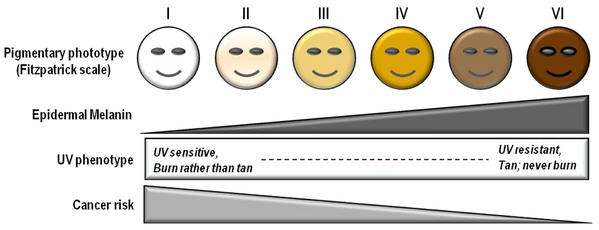
Kissed by the Sun
When the UVR hits our skin, there are many consequences. First, we must differentiate acute exposure to sun radiation from chronic exposure. Acute exposure leads to sunburn, severe skin damage, dehydration, coma and even death. Children and elderly are more susceptible to sun acute exposure due to lack of properly working alert system (they have less symptoms). On the other hand, chronic sun exposure is more subtle. You can sunbath without getting sunburn but even this way, there are changes that happens under your skin which can affect your health.
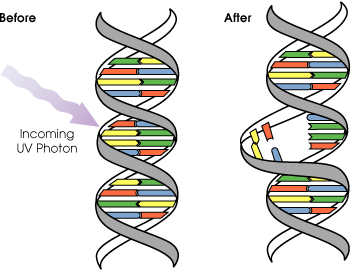
UVB is the smallest part of UV radiation and has a low penetrating power. UVB will hit mainly the epidermis, with good and bad consequences. UVB helps our skin to synthetize some antimicrobial peptides and the pro-vitamin D, which is essential for our calcium metabolism. On the other hand, UVB are responsible for sunburn, skin aging and skin cancer. The latter is caused by DNA damage in the active cells found in the germinal layer: if the DNA of one of these cells get an oncogenic mutation, the cell goes crazy and may develop a cancer. Fortunately, we have several DNA repair mechanisms and a natural UVB filter, called melanin. When UVB hits melanocytes in the germinal layer of epidermis, their melanin production increase: our skin become darker gain the ability to filter UVB radiation. However, this change happens only after some days of exposure: this is why in first days of sunbathing we need to be careful and reapply every time we can the sunscreen.
UVA are much more dangerous. They have high penetrating power and so they reach the dermis. This means they will less likely cause sunburn but they will alter fibroblasts production and extracellular matrix proteins. The high energy of UVA can split molecules increasing the reactive oxygen species (ROS) in the cutis. As the name suggest, ROS can react with proteins, DNAs and almost every molecule, disrupting them. In other words, UVA are responsible for skin aging, dehydration, loss of skin elasticity and in some extent, for cancer.
Keep calm and protect your skin
So far, things seems to be scary, huh?
Of course, our body has tons of defence mechanisms; otherwise, everyone would act as vampires do. Our cells have DNA repair mechanism that works steadily to avoid genetic damage. They also have some proteins that can react with ROS, neutralizing them. In addition, melanin help our skin to absorb UVR. Still, we can and we should help our body to defend against UVR, especially if we aim to get a suntan.
Please note that everyone one is going outdoor during summer is exposed to UVR, not only people going for sunbath. The precautions listed below should be considered even for people going for outdoor training, working outdoor or simple going for a long walk.
- Keep hydrated. During summer, our body lose water by sweating to keep our temperature in the safe range. Water is extremely important because it’s used in the dermis to give elasticity and it also is needed to skin cells (and any other cell) to maintain their metabolism (and so all the protective mechanisms seen above). Some people may sweat a lot, other may sweat less but please be careful with the children and the elderly: sometimes if they don’t sweat at all it’s because they are dehydrated. Some energy drinks are really good during summer (Energade, Gatorade, etc.) because they contain also minerals that we lose during sweating. Keep hydrated is the best way to avoid heatstroke.
- Cover yourself. This helps a lot especially when the sun is high in the sky. Using hats and light clothing will keep you fresh and will act as mechanic filter for UVR.
- Eat fruit and vegetables. Not only they contain lot of water but they also contain lot of vitamins and antioxidants, which help eliminating ROS from our body.
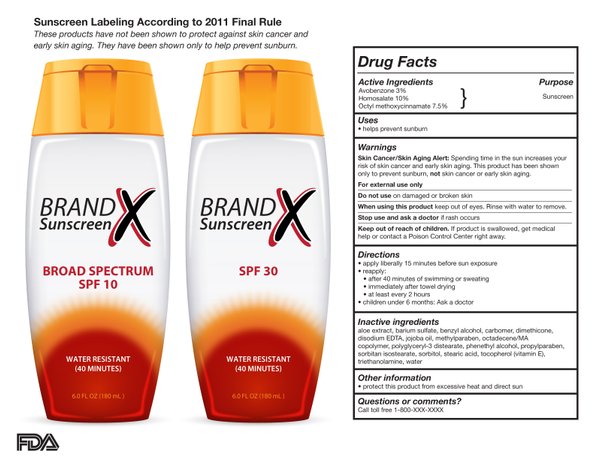
- Use sunscreen. The most important thing to know about sunscreen is the meaning of SPF and its value. SPF stands for Sun Protection Factor and it measure the sunscreen protection from UVB. A double value of SPF does not mean a double sunscreen protection: a SPF 30 lotion can stop only 4% more UVB than a SPF 15 lotion (97% vs 93%). SPF 50 stops 98% of UVB radiation, so it’s clearly not a big deal compared to a SPF 30 sunscreen: this is why most of dermatologist recommend using a SPF 15 and SPF 30 sunscreen. I bet you noticed SPF refers only to UVB and not to UVA: in fact, the dangerous effects of UVA were discovered later compared to UVB’s. This is why the best sunscreen is a “broad spectrum” sunscreen, which protects from UVB and UVA. Other than SPF it’s really important to know how much and how often a sunscreen should be applied: recommendations are 2 mg/cm2 of skin (1 ounce or 30 grams for whole body) and it should be reapplied at least every 2 hours.
Sunburn and heatstroke: what to do?
If you get a sunburn (1st degree burn), some of you could be tempted to put ice on it. That’s really a bad thing to do. The cold will reduce blood flow to the skin, increasing damage and preventing heat flow going away from the body. The best thing to do is to put the burned area in cool water for 10-15 minutes. If there are blisters on sunburn (2nd degree burn) do not pop them and let them heal on their own: popping them could result in serious skin infection. Moreover, drink extra water, cover burnt areas to avoid further damage and use anti-inflammatory medications if there is too much pain. Sunburn will heal itself in 5-7 days. The best thing to do againts sunburn is still just one: simply avoid getting it using sunscreen and all the tips above. On the other hand, heatstroke is more dangerous, especially in childred and elderly. Main symptoms are high body temperature (without sweating), vomit, nausea, sleepiness, confusion: sometime this could lead to seizures, coma and eventually death for organ failure. Again, while prevention is absolutely the best option, if you notice some of these symptoms in someone close to you, contact immediatly a emergency services and try to keep this guy as cool as you can. As for sunburn, avoid cold water and prefer cool water, sponge or spray him with water, put him in a shady area, undress and try to vent him while waiting for the help to come.
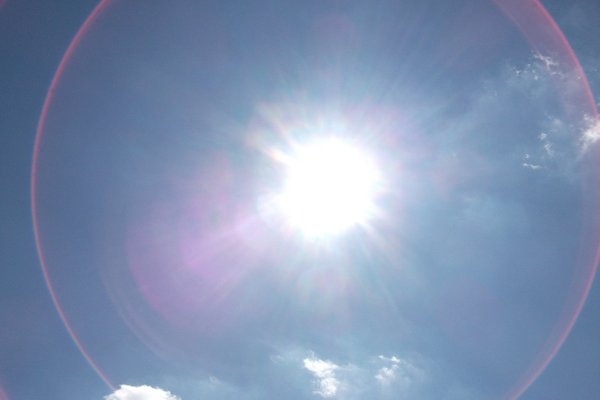
Now you have all the information you need to get a perfect (and healthy) suntan. Drink a lot, use sunscreen and avoid sunbathing from noon to 2 pm. But most of all, enjoy your hard earned relaxation!
Click on the coin to join our Discord Chat

Witness proposal is here:
Go To Steem Witness Page
In the bottom of the page type: adsactly-witness and press vote.

Use small letters and no "@" sign. Or, click here to vote directly!
Thank you!
Thank you for this useful content .. I would to say that the sun has many benefits, however, it should not be abused.
Preparing your skin for the sun is important. But it must be remembered that self-tanners and food supplements do not protect from the sun.
Effective and adapted sun protection is essential to reduce the penetration of UV rays into the skin.
It is necessary to renew the application of sunscreen frequently during the exposure.
It is advisable to wear covering clothing when exposed to UV rays.
Avoid exposure to the sun in the middle of the day.
Whatever the child's phototype, his skin is thinner and therefore more fragile than that of an adult. So you have to be extremely vigilant.
You have to drink in abundance.
Despite excellent protection, the application of a care after sun relieves the skin and repairs the inconvenience.
Happy Holidays
So I was at Disney World when Hurricane Mathew happened (It was after pretty sure) and I was swimming in a pool. After a few hours in the pool, I came back and mom noticed I had sunburns on my shoulders and part of my back - * IT WAS VERY SPECIFIC. However, my arms, legs, face were safe.* - You could mostly see where the swimsuit was. When I got back, my shoulders were burning and was super hard to calm down. Eventually, mom gave me a painkiller drug that kicked in within 10 - 15 minutes. That was the worst sunburn I ever had O.o
This is how it happens most of time. We just say ourselves "it is just for today" and we dont take any precautions..but that's when the sun hit harder!
The human body is such an object that it is very difficult to hide. But it is not possible to hide it. A little walking is caught in the eyes of other people. Forced to catch If there is a disease in the body, then there is no word. Everyone will start asking him, is this your body bad? Is this your brother, is your body bad?
No one can say that if he wishes, no brother, my body is not bad. Because it will be caught in front of the eyes that his body is bad.
Walking, conversations, ups and downs - Everyone will see that the other person's body is bad. It will be difficult to avoid the truth even if you want to. But mind? It is a matter of great difficult. The mind is also an existence similar to the body. But helpless is a figure. It can not be seen in the eye, can not be tested with machine, X-ray can not be done. But this mind can sometimes get worse due to the laws of nature, or it may become ill or it may be. And the clever people can deny this mindset in front of people. Even if someone asks, is your heart bad brother today? Looks like the appearance. Soon he said, smiling laughing smile, hey, no, no, why should the mind become bad? I do not have any tragedy! If the only unrest is the mind of the people...
good
First of all great description of our skin. It’s amazing the way our body is build. It’s amazing the way our scum is build. All these layers, all these cells and yet it’s so fragile.
Just hearing word “radiation” sounds scary 😱 right? It even sounds almost like sun is our enemy. The truth is the opposite. As a matter of fact sun is the main factor giving us great amount of vitamin D. Vitiming D is very important for our body. In other words I would even call vitamin D a little soldiers. Litle soldiers that fight against cancerous cells which I was personally impacted by. In North America especially in the United States very low level of vitamin D is one of the main reasons there is so many people impacted by this horrible decease especially melanoma skin cancer. Sun is definitely not our enemy. As you mentioned, as long as you don’t overdo your sun exposure to the point where you get sunburn or even a heatstroke the sun will always be your friend. Avoid sun when it’s most dangerous. I personally try not to get sun exposure between 11am-4pm. If you avoid these things the sun will always be your friend. And of course drinking a lot of water. I personally am against using any suntan or even any sunscreens. In my opinion it’s all chemicals and chemicals harm our body more than our friend sun. But that’s my opinion.
Great article @adsactly!
That is so beneficial to our health and in order to maximize the benefits, add to your list to do "grounding" also. Just walk barefoot in the sand to that your body will directly connected to the earth and reducing radiation to your body. You can research also about the benefits of grounding to our body.
I know getting a little skin exposure daily is a good thing, but how much? If I only expose my neck and lower legs to the skin on a daily basis, is that ok? I'm not too fond of sunscreen as I've heard the chemicals in it are harmful to the body so I wear long-sleeved shirts and a hat.
Thank you so much for explaining everything about skin layers. These tips are really helpful for me because I am facing the problem with hot weather and suntan.
Our skin & eyes are also effecting by the harmful UV rays of the Sun Light. Because of Ozone layer depletion and Green House effect. So to resolve this problem save nature save life.
Thank you :-)
Glad that all these information are useful ! Enjoy your suntan!
I have never worn it, and have never known anyone who does, sunscreen is for people who go out in the sun once a year or have skin conditions, I typically spend 3-4 hours walking around topless outdoors, never had a problem because I'm used to it unlike people who decide go out to sunbathe for the first time of the year and stay out until dawn
Hello im a boy whos highly concious about my skin, i would love to use sunscreen with natural ingredients and does not function as other things like make up(foundation etc), what do u recomend? and what about removing it? Do we have to use any make up remover or how (because some is water resistant) also i live in a tropical country so its very hot and humid so any scented sunscreen is a no no, please help me i would also like to know more about lips sunscreen
I think your use of the words suncream, sunscreen and sunblock are misleading, they're all different items. And if your directions are to put on sun cream 30 mins, you should indicate that you're referring to chemical sunscreens and no sunblock.